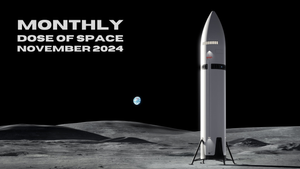
Aug 1, 2024
Cosmic Curiosities - August 2024
Hello and welcome to the very first "Cosmic Curiosities" newsletter! In this new monthly newsletter, we will go over the big astronomy events you should expect in the coming month. From meteor showers to planetary aligning and anything in between. We also will dive into all of the out-of-this-world discoveries and big stories from the past month!
(note: this is the first edition of this newsletter and it will be improved and refined down the line)
What's up this month?
August is going to be full of awesome space events, so get your telescope (or eyes) ready as we go over what's up this month!
The Perseid Meteor Shower - August 11-12th

August is home to one of the most exciting meteor showers, Perseid. The popular shooting star spectacle will peak on Sunday, August 11th, and into the early morning hours of Monday, August 12th. You should also see some shooting stars here and there a couple of days before and after the meteor shower peaks. This may be one of the best showers this year due to the nice weather in the northern hemisphere, as well as the dim Moon. When the Perseid meteor shower peaks, the Moon will be in a Waxing Crescent phase, with an illumination of about 40%. If you watch this cosmic ballet at its peak, you should expect to see upwards of 60 shooting stars per hour!
Blue Moon - August 19th

A week after the peak of Perseid, the Moon will steal the show as it becomes a "Blue" Moon. Sadly, our celestial neighbor won't turn blue, it is just the third full Moon in a season that has four, making it a "seasonal blue moon." The first full Moon of this season was on June 21st, the second on July 21st and the fourth will be September 18th. Referring to the third full Moon in a season came from the now defunct Maine Farmers' Almanac that if one of the four seasons in a year, contained four full Moons instead of the conventional three, the third should be called a "blue moon" to sort of honor the occasion. This will be the first (and only) Blue Moon of the year. The next monthly blue Moon will be in May of 2026 and the next seasonal blue Moon will occur in August of 2027. So, while the Moon sadly will remain the same color, it is still something to look forward to this month!
Moon and Saturn (ft. Neptune) - August 20th

Just a day after taking all the limelight, the Moon once again is the star of the show as it and Saturn are going to be side by side all night. After the sun sets on Tuesday, Saturn, one of the easiest to spot planets in the night sky will rise just above our celestial neighbor. This will be an amazing thing to see, especially if you own binoculars or a telescope. Neptune will also make an appearance during this event down to the left of the Moon and Saturn. However, you unfortunately won't be able to see the far-out ice giant with the naked eye.
Interstellar news from July
Last month was quite up and down when it came to rocket launches. However, while Falcon 9 was grounded and then returned to flight, Ariane 6 suffered a second-stage anomaly, and Starliner extended its stay aboard the ISS; astronomers and planetary scientists around the world continued to explore our cosmos. Here are some of the big discoveries and news events from the wacky month in space, that was July!
Perseverance spots an interesting rock

In the Jezero Crater on Mars, Perseverance spotted an interesting rock that could hint at potential microbial life billions of years ago. The reddish rock, nicknamed "cheyava falls" is littered with leopard spots. These spots are theorized to have supported microbial life via chemical reactions within the rock, but other explanations are being looked into. According to Ken Farley, the Perseverance project scientist of Caltech:
Cheyava Falls is the most puzzling, complex, and potentially important rock yet investigated by Perseverance......On the one hand, we have our first compelling detection of organic material, distinctive colorful spots indicative of chemical reactions that microbial life could use as an energy source, and clear evidence that water necessary for life once passed through the rock. On the other hand, we have been unable to determine exactly how the rock formed and to what extent nearby rocks may have heated Cheyava Falls and contributed to these features.”
After spotting such an interesting rock, the six-wheeled explorer conducted an onboard analysis of the rock using a suite of instruments; which proved that the rock contained all the necessary properties to potentially host microbial life. Adding that, with the fact that the area the rock was in once had flowing water, things are looking hopeful that life once inhabited this now barren world. However, we need to learn more about the rock before we jump to conclusions. For the sake of time, we cannot dive completely into the intricacies of this discovery, so if you want to read the full press release from JPL, click here!
Webb images a cold exo-planet 12 light years away

Epsilon Indi Ab, a gas giant several times the mass of Jupiter is one of the coldest exoplanets we have observed to date. This exoplanet orbits the K-type star Epsilon Indi A, which is around the age of our Sun, just slightly cooler. Using the coronagraph on Webb's Mid-Infrared Instrument (MIRI) an international team of Astronomers observed the 12th closest exoplanet to us in great detail. While Epsilon Indi Ab is warmer than gas giants within our solar system by about 82 degrees Celsius or 180 degrees Fahrenheit. However, it is the coldest exo-planet we have ever observed, this is because as planets age, they become cooler and thus are harder to spot at great distances.
Cold planets are very faint, and most of their emission is in the mid-infrared. Webb is ideally suited to conduct mid-infrared imaging, which is extremely hard to do from the ground. We also needed good spatial resolution to separate the planet and the star in our images, and the large Webb mirror is extremely helpful in this aspect.” - Elisabeth Matthews of the Max Planck Institute for Astronomy in Germany
Because Epsilon Indi Ab is so close to Earth (relatively) its cooler temperature doesn't hinder our ability to spot it. This provides astronomers on Earth an amazing chance to study a star system that is an analog to our own. Astronomers on Earth didn't expect the gas giant to be as faint as it is, which leads them to believe that the atmosphere of the planet is comprised significantly of methane, carbon dioxide, and monoxide, absorbing the shorter wavelengths of light. The gas giant also could just have a very cloudy atmosphere.
Chandra celebrates 25 years since its launch

NASA's flagship x-ray telescope, Chandra celebrated 25 years in space after its launch on July 23rd, 1999. Since getting flung into low Earth orbit by Space Shuttle Columbia Chandra helped humanity unravel the mysteries of the universe. Being 8x more powerful than any other X-ray telescope, Chandra is a true pillar in the space industry that has captured some truly jaw-dropping images. To date, Chandra has observed 25,000+ objects over its quarter-of-a-century mission.
Despite being one of NASA's "Great Observatories" along with the Hubble telescope, Chandra is at threat due to budget cuts. Two of the other great observatories, Spitizer and Compton have been retired, however, both were due to either mechanical failures or running out of fluids. It would be a true shame that Chandra, a perfectly healthy telescope with no predecessor in the works would fall victim to bureaucracy. While nothing is completely set in stone yet, NASA's 2025 budget envisions Chandra as being essentially retired in 2029 as its budget goes from 60 million USD in 2023 to just 6 million USD in 2029. Hopefully, the necessary allocation of funds and resources can be given to those overseeing Chandra, as this is truly the best x-ray observatory we have built as a species. So, while the future is uncertain, let's hope Chandra has many more anniversaries and scientific discoveries!

On July 31st, NASA's NEOWISE telescope officially retired and will soon burn up into the Earth's atmosphere in the coming days. Originally the Wide-field Infrared Surveyor Explorer (WISE) was intended to explore the universe in Infrared wavelength. Launched in 2009 onboard a Delta II rocket, WISE would go on to repeatedly map the night sky and catalog billions of objects. From faint and cold brown dwarfs to dazzling galaxies. After over a year of scientific exploration, WISE completed its main scientific objectives and was put into hibernation. However, in late 2013 the orbital observatory was brought back to life and given a new mission dedicated to identifying and characterizing the population of near-Earth objects, giving it the name ”NEO” WISE. Since then, the orbital telescope has observed upwards of 3,000 near-Earth objects, helped humanity further develop and refine planetary defense strategies, and helped support NASA’s missions to asteroids.
All in all, NEOWISE has truly been a pillar of humanity's cosmic observation. From the universe at large, to specks of rock near our planet, NEOWISE has undoubtedly helped man better understand our place in the cosmos. It is sad to see such an icon finally being put to rest, but we should celebrate all the achievements little NEOWISE made!
Celestial Spotlight
Finally, lets quickly go over the best astrophoto of the previous month. In the next edition of this newsletter, this segment will be expanded upon to include the best astrophoto from each week as well as the best of the month. However, to keep it simple, today we are just going to cover the best astrophoto of July.

Galactic Cluster J0416 as seen by Chandra and JWST
Of course, the best astrophoto of July had to be this image taken by the Chandra X-ray Observatory and the James Webb Space Telescope. As part of Chandra's 25th anniversary, NASA unveiled a bunch of photos to celebrate the occasion. This one immediately caught our eye and is one of the most stunning deep-space photos to be released this year.
Combining data from both Chandra and Webb, astronomers got this image in return. This particular galactic cluster is some 4.3 BILLION light-years away, for comparison, the closest galaxy to our own, Andromeda, is a relatively close 2.5 million light-years away, give or take. The purple you see arching across the image is a reservoir of superheated gas that was captured by the Chandra telescope. There are hundreds of galaxies in this image, all with hundreds of billions of stars. The universe is truly a mysterious and beautiful thing and we are so lucky to experience it.
Well, that wraps up everything for this month’s Cosmic Curiosities! We truly hope you enjoyed this new newsletter. If you read this far, thank you and we look forward to seeing you back in September!



